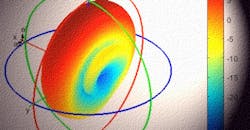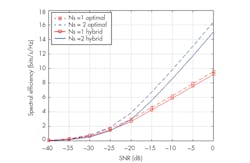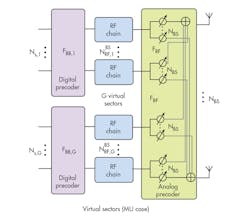Algorithms to Antenna: Achieve System Performance Goals with Less Hardware
For those of you with a background in large phased-array radar systems, the design concept of using subarrays to map multiple elements to a single transmit/receive (T/R) module will be familiar. In the previous generation of phased-array systems, the need to feed T/R modules from many elements was driven more by the complexities of bundling and routing large amounts of cabling, delay lines, and switches for arrays that may have more than a thousand elements. Today, we see a similar technique in use in 5G system design with hybrid beamforming.
Because 5G goals include higher data rates, lower latency network accesses, and more energy-efficient implementations, systems need to achieve higher data rates using much larger bandwidths to communicate. Since the available bandwidth in the spectrum up through 6 GHz is not sufficient to satisfy these requirements, the operating frequency bands move up into the millimeter-wave (mmWave) range.
With the much smaller wavelengths at these higher frequency bands, implementations with many more antenna elements per system within very small form factors are in play. Signal path and propagation challenges associated with operating at these frequencies increase over sub-mmWave frequencies. Channel models will be a topic for a future blog, but these types of propagation losses can be compensated for with array design and spatial signal processing techniques, including hybrid beamforming. As we saw in our previous installment, beamforming is possible with large, multi-element arrays and can be used directly to provide higher link-level gains to overcome path loss and undesirable interference sources. (Part 1 can be found here.)
To achieve the most control and flexibility with beamforming in an antenna array design, it is desirable to have independent weighting control over each antenna array element. This requires a T/R module dedicated to each element. For array sizes that are typical of a large MIMO communication system, this type of architecture is difficult to build due to cost, space, and power limitations. For example, having a very high-performance ADC and DAC for every channel (along with the supporting components) can drive the cost and power beyond allocated design budgets. Similarly, having variable gain amplifiers in the RF chain for each channel increases the system cost.
Now we come to the need to implement hybrid beamforming in large systems. Hybrid beamforming is a technique that can be used to partition beamforming between the digital and RF domains. Recall from part 2 that we need to implement beamforming for a few big reasons:
- To increase the SINR, which means reducing undesirable interference noise sources
- To mitigate losses from mmWave operations
- To cover the multi-user case with spatial multiplexing
It is possible to implement hybrid beamforming in a way such that a balance between flexibility and cost is achieved while still fielding a system that meets the required performance parameters. Hybrid beamforming designs are developed by combining multiple array elements into subarray modules. A T/R module is dedicated to a subarray within a larger array, and therefore fewer T/R modules are required in the system. The number of elements, and the positioning within each subarray, can be selected to ensure that system-level performance is met across a range of steering angles. This translates directly into less system hardware.
Figure 1 below is from a more detailed example where we look at how systems can be partitioned between the RF and digital domains. In the spectral efficiency plot, you can see how close the performance can be between the hybrid case and the “all digital” case.
1. These plots illustrate spectral efficiency for “all digital” versus hybrid partitioning.
You can explore designs directly through this example to see where the design architecture needs to be by mapping your system to one of the cases in Fig. 2.
2. Shown are possible partitioning strategies.
In the example, we use a system with 64 elements that is built up from four panels, where each panel is a 4-×-4 array (Fig. 3). We picked this configuration because it was easier to explain, but it could be extended to match your design. The system realized from this workflow achieves the desired beam steering resolution in both the azimuth and elevation of the rectangular array.
3. This figure illustrates a hybrid beamforming example with RF and digital steering.
In subsequent blog posts, we will look at other system configurations to measure performance against, including the multi-user system (Fig. 4) where we use the RF steering to create concentric rings in an area of coverage (for “coarse” steering resolution), and digital steering to achieve “fine” steering resolution within the rings. We will also explore how models of RF components and actual antenna element patterns can be added for additional fidelity.
4. Shown is a typical virtual sector case for multi-user systems.
Learn more about topics covered in this blog post:
- Modeling the Emerging 5G Standard with the 5G Library (technical article): In this two-minute read, learn more about the 5G Library from MathWorks, which provides executable versions of features defined by the new 5G standard.
- Introduction to Hybrid Beamforming (example): Learn the basic concept of hybrid beamforming and how to simulate such a system.
See additional 5G, radar, and EW resources, including those referenced in previous blog posts.
About the Author
Rick Gentile
Product Manager, Phased Array System Toolbox and Signal Processing Toolbox
Rick Gentile is the product manager for Phased Array System Toolbox and Signal Processing Toolbox at MathWorks. Prior to joining MathWorks, Rick was a radar systems engineer at MITRE and MIT Lincoln Laboratory, where he worked on the development of several large radar systems. Rick also was a DSP applications engineer at Analog Devices, where he led embedded processor and system level architecture definitions for high performance signal processing systems used in a wide range of applications.
He received a BS in electrical and computer engineering from the University of Massachusetts, Amherst, and an MS in electrical and computer engineering from Northeastern University, where his focus areas of study included microwave engineering, communications, and signal processing.





